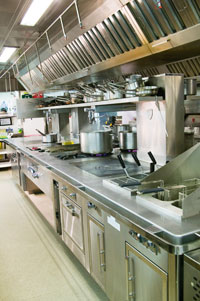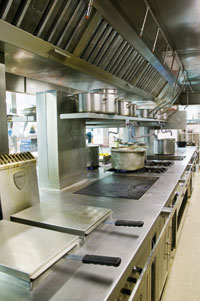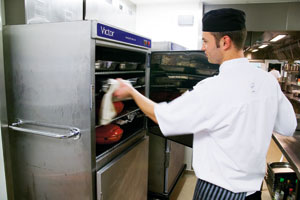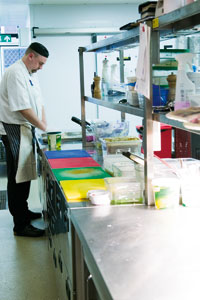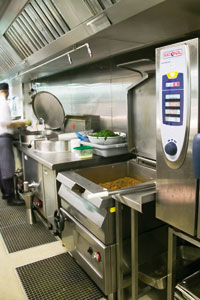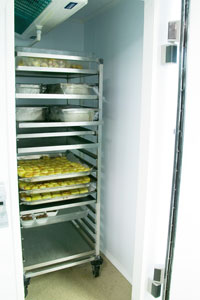My new kitchen: One Great George Street, London
The decision to bring the catering in house at London venue One Great George Street required extensive planning and substantial investment, not least because the kitchen has to serve two public outlets and 19 function and banqueting rooms. Diane Lane spoke to executive chef David Wilkinson
It was five years in the planning and cost a whopping £1m, but all the time and money invested in the new kitchen at One Great George Street in Westminster is paying huge dividends.
The Edwardian building, just a stone's throw from the Houses of Parliament, dates back to 1910 and is home to the Institution of Civil Engineers. It sees a host of functions, from small meetings to gala dinners and weddings, in its 19 rooms with capacities from six to 400, and alongside the banqueting operation runs the 60-seat Brasserie One and adjoining Café Bar, which are both open to the public.
The problem with the old kitchen was that it wasn't designed for the catering operation as it is today. Previously, it was set up for outside caterers to use for finishing. However, the arrival of executive chef David Wilkinson in June 2000 signalled a change, and within a year all the catering was brought in house.
"We increased the staff and fought to cater for a lunch for 150 which Prince Philip was attending," says Wilkinson. "We did it, and then things changed." That's when talk about a kitchen upgrade started.
With just one 20-grid combi-oven and no bratt pans the kitchen was in no way geared up for the bulk cooking that was about to come its way. "We were getting busier and finding it harder to keep up," says Wilkinson. "Technology had moved on, and we obviously needed more combis and more storage space."
Working alongside Mike Bridger, business development manager at CEDA member Airedale Catering Equipment, Wilkinson and director of One Great George Street Gary Payne set about creating a kitchen capable of supporting the needs of the entire catering operation - both banqueting and restaurant service, the latter being the domain of head chef Alex Galpin.
The starting point was sorting out the flow. The wash-up area had to move so that waiting staff wouldn't have to pass through the kitchen to drop off plates, and the cold section needed to be in a cooler part of the room. Dry stores and chef's office were relocated to create more space, and the whole operation became more open-plan.
On the cooking side, original thoughts included separate suites for the two styles of operation. However, in consultation with Colin Leonard, UK sales manager of Charvet, the decision was taken to have one huge 6m x 2m bespoke suite with one side kitted out for banqueting and the other for restaurant service.
There are three ovens in the suite, and at one end the two sides mirror each other with a pair of 800mm salamanders and 800mm x 550mm solid-tops. A bain-marie sits underneath the salamanders and has a stainless-steel flat cover which sits flush with the suite's 3mm-thick stainless steel and titanium top to provide plenty of work space.
Further down the suite there's another pair of solid-tops back to back and two sets of two Volcan open burners. "I'm a bit of an old traditionalist, me," says Wilkinson. The banqueting side has a further two burners and a cast-iron ribbed plancha.
Two gas high-output fryers on the banqueting side have a capacity of 16 litres, while a smaller 2 x 7-litre electric fryer is sufficient for the restaurant's needs. More restaurant kit includes a six-basket pasta cooker plus a gas chargrill and a chrome smooth plancha for direct cooking.
Running along the wall on the banqueting side is a modular suite of serious bulk-cooking equipment, including two jacketed boiling pans, each with a 150-litre capacity, and two bratt pans.
The number of combi-ovens has more than doubled, with two gas 20-grid models and an electric 10-grid, all by Rational. Sited close by, next to the door used for sending banquets, are two Victor Banquetline 100 heated trolleys for transporting gastronorm containers of food to the various function rooms, including the impressive President's dining room.
All refrigeration is linked to a Digitron DigiTrack RF wireless temperature-monitoring system, which keeps records and also raises the alarm in the event of a problem.
Also sited here is a Sammic vacuum-packing machine, which helps to prevent freezer burn on the occasions goods are frozen down.
Bulk storage has been arranged at one end of the kitchen to form the goods-in area, with three Storer coldrooms, the largest of which sits just outside the entrance to the kitchen and is used as a drystore - plus a freezer room and a walk-in blast chiller suitable for rolling in trolleys.
Sliding doors are a space-saving measure on the coldrooms and freezer, while one coldroom and the freezer are double-ended to allow access from both inside and outside the kitchen.
The new arrangement has transformed the working environment for Wilkinson's brigade of nine chefs and three kitchen porters, and he is happy they can now do the production in house with relative ease - and happy to have a kitchen that has caught up with technology.
The side of the suite geared up for restaurant service provides everything needed for both direct cooking and pan work, with a smooth chrome plancha, chargrill, solid-top and open burners, with a pasta cooker - also used for veg - and a fryer thrown in for good measure.
The banqueting side of the suite has plenty of fire power in the form of two 11kW solid-tops and four 9kW Volcan open burners for all those big pans. The fryers here have a capacity of 16 litres and a power rating of 16kW.
Ferrying trays of food around the building is the job of two Victor Banquetline 100 trolleys capable of holding 22 full-size gastronorm containers. The heated units are adjustable between 65°C and 95°C, with digital temperature readout on the microprocessor control.
The fabrication forming the hot pass continues to provide a run of prep space complete with underâ€'counter refrigeration with a mix of doors and drawers.
A modular suite of tilting bratt pans and jacketed boiling pans facilitate the bulk cooking for the banqueting operation. Besides hot food, the boiling pans also come in handy for tasks such as washing large quantities of lettuce.
A walk-in blast chiller is big enough to accept trolleys and quickly pulls down the temperature of cooked foods in compliance with regulations.
Contacts
- Airedale Catering Equipment/Caterform 01274 626666 www.airedale-group.co.uk
- CEDA www.ceda.co.uk
- Charvet 01342 717936 www.charvet.co.uk
- Digitron 01803 407693 www.digitron.co.uk
- Electrolux Professional 0121-220 2800 www.electrolux-professional.co.uk
- Foster Refrigerator 0500 691122 www.fosterrefrigerator.co.uk
- Rational UK 0800 389 2944 www.rational-uk.com
- Sammic 0116 246 1900 www.sammic.com
- Storer Refrigeration 0115 920 0329 www.storerref.co.uk
- Victor Manufacturing 01274 722125 www.victoronline.co.uk


